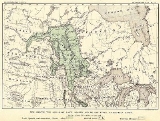
Lake Agassiz
Overview
Glacial lake
A glacial lake is a lake with origins in a melted glacier. Near the end of the last glacial period, roughly 10,000 years ago, glaciers began to retreat. A retreating glacier often left behind large deposits of ice in hollows between drumlins or hills. As the ice age ended, these melted to create...
located in the center of North America
North America
North America is a continent wholly within the Northern Hemisphere and almost wholly within the Western Hemisphere. It is also considered a northern subcontinent of the Americas...
. Fed by glacial runoff at the end of the last glacial period, its area was larger than all of the modern Great Lakes
Great Lakes
The Great Lakes are a collection of freshwater lakes located in northeastern North America, on the Canada – United States border. Consisting of Lakes Superior, Michigan, Huron, Erie, and Ontario, they form the largest group of freshwater lakes on Earth by total surface, coming in second by volume...
combined, and it held more water than contained by all lakes in the world today.
First postulated in 1823 by William Keating, it was named by Warren Upham
Warren Upham
Warren Upham was a geologist, archaeologist, and librarian who is best known for his studies of glacial Lake Agassiz. Upham worked as a geologist in New Hampshire before moving in 1879 to Minnesota to study the resources and glacial geology of that state...
in 1879 after Louis Agassiz
Louis Agassiz
Jean Louis Rodolphe Agassiz was a Swiss paleontologist, glaciologist, geologist and a prominent innovator in the study of the Earth's natural history. He grew up in Switzerland and became a professor of natural history at University of Neuchâtel...
, after Upham recognized it was formed by glacial action.
Geologists have come to a consensus on the likely geological history of Lake Agassiz.
During the last Ice Age
Ice age
An ice age or, more precisely, glacial age, is a generic geological period of long-term reduction in the temperature of the Earth's surface and atmosphere, resulting in the presence or expansion of continental ice sheets, polar ice sheets and alpine glaciers...
, northern North America was covered by a glacier, which alternately advanced and deteriorated with variations in the climate.
Unanswered Questions

